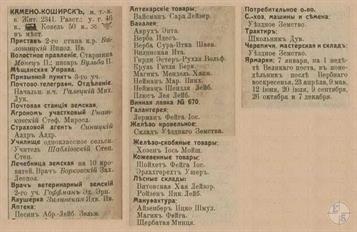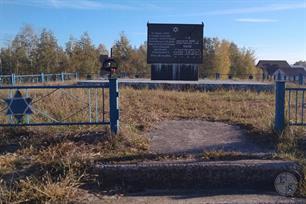Kamin-Kashyrskyy
Volyn region
Sources:
- Russian Jewish encyclopedia;
- The All South-Western Territory: reference and address book of the Kyiv, Podolsk and Volyn provinces. Printing house L.M. Fish and P.E. Wolfson, 1913;
- Virtual Shtetl. Kamien Koszyrski;
- Encyclopedia of Jewish Life Before and During the Holocaust, vol. 2, eds. Sh. Spector, G. Wigoder, New York 2001, p. 592.
Photo:
- European Jewish Cemeteries Initiative. Kamin-Kashyrskyy Jewish Cemetery;
- Viacheslav Galievskyi, Wikipedia. Memorial sign to Jewish ghetto in Kamin-Kashyrskyi;
- Biblioteka Narodowa Polona. Kamien Koszyrski
- Tomek Wisniewski, Bagnowka. Kamien Koszyrski
- Russian Jewish encyclopedia;
- The All South-Western Territory: reference and address book of the Kyiv, Podolsk and Volyn provinces. Printing house L.M. Fish and P.E. Wolfson, 1913;
- Virtual Shtetl. Kamien Koszyrski;
- Encyclopedia of Jewish Life Before and During the Holocaust, vol. 2, eds. Sh. Spector, G. Wigoder, New York 2001, p. 592.
Photo:
- European Jewish Cemeteries Initiative. Kamin-Kashyrskyy Jewish Cemetery;
- Viacheslav Galievskyi, Wikipedia. Memorial sign to Jewish ghetto in Kamin-Kashyrskyi;
- Biblioteka Narodowa Polona. Kamien Koszyrski
- Tomek Wisniewski, Bagnowka. Kamien Koszyrski
Kamin-Kashyrskyy, city (since 1939), district center. Known since 1196. In the 16-18 centuries - as part of the Commonwealth. Since 1793 - as part of the Russian Empire. In the 19th - beginning of the 20th century - the town of Kamen-Kashirsk of Kovel district of the Volyn province.
In 1919–39 - in the Polesie Voivodeship as part of Poland, in 1939–91 - as part of the Ukrainian SSR.
In 1847, 862 Jews lived in Kamin-Kashyrskyy;
in 1897 - 1189 (97.5%),
in 1921 - 617 (48.8%),
in 1937 - approx. 1700 Jews (ca. 60%).
In 1919–39 - in the Polesie Voivodeship as part of Poland, in 1939–91 - as part of the Ukrainian SSR.
In 1847, 862 Jews lived in Kamin-Kashyrskyy;
in 1897 - 1189 (97.5%),
in 1921 - 617 (48.8%),
in 1937 - approx. 1700 Jews (ca. 60%).
 |
 |
| Kamin-Kashyrskyy in the 1913 directory of Volyn province | Fragment of postcard, 1933. There is a Chasid in traditional clothing in the center |
The community was not reborn in its former shape, especially since its initial development was stunted by World War I. Since 1918, a detachment of self-defense was created, which in September 1920 prevented 2 attempts by pogrom made by Bulak-Balakhovich detachments.
In December 1920, the detachments of Bulak-Balakhovich were arranged pogrom, during which more than 120 Jews were killed.
According the census of 1921, there were only 617 Jews per 1,265 inhabitants (48.8%).
Social changes were conducive to the spread of Zionism. In the interwar period, a Jewish library and a school belonging to the Tarbut network operated.
Since 1921, the rabbi in Kamin-Kashyrskyy was Moishe-Mordhe Perlin (? –1940).
On the 2nd day of the Feast of Shavouot in 1937, a pogrom occurred in the town. Local authorities stopped him, but instead of the pogromers, shoykhet and a correspondent of the Jewish newspaper were arrested, who sentenced to imprisonment for 6 months and 1 year, respectively.
In December 1920, the detachments of Bulak-Balakhovich were arranged pogrom, during which more than 120 Jews were killed.
According the census of 1921, there were only 617 Jews per 1,265 inhabitants (48.8%).
Social changes were conducive to the spread of Zionism. In the interwar period, a Jewish library and a school belonging to the Tarbut network operated.
Since 1921, the rabbi in Kamin-Kashyrskyy was Moishe-Mordhe Perlin (? –1940).
On the 2nd day of the Feast of Shavouot in 1937, a pogrom occurred in the town. Local authorities stopped him, but instead of the pogromers, shoykhet and a correspondent of the Jewish newspaper were arrested, who sentenced to imprisonment for 6 months and 1 year, respectively.
Since 1939, teaching at the Tarbut school was transferred to Yiddish.
On June 26, 1941, parts of the Red Army left the town. During the pogrom arranged by the local population, 2 Jews were killed.
Germans entered the town on 2 August 1941, immediately murdering 78 Jews. In June 1942, over 3,000 Jews (including a large group of refugees) were imprisoned in a ghetto. On 10 August 1942, all of its prisoners except for 600 qualified workers were shot. The final liquidation of the ghetto took place on 2 November 1942. Ca. 400 people tried to escape. About 100 Jews managed to join partisan units.
On June 26, 1941, parts of the Red Army left the town. During the pogrom arranged by the local population, 2 Jews were killed.
Germans entered the town on 2 August 1941, immediately murdering 78 Jews. In June 1942, over 3,000 Jews (including a large group of refugees) were imprisoned in a ghetto. On 10 August 1942, all of its prisoners except for 600 qualified workers were shot. The final liquidation of the ghetto took place on 2 November 1942. Ca. 400 people tried to escape. About 100 Jews managed to join partisan units.
The earliest record of Jews in Kamin-Kashyrskyy dates back to 1569. The community was under the jurisdiction of the Kovel rabbi. In 1897, they constituted 97.5% of the town’s population. Most made a living from petty trade (including door-to-door sales) and crafts, largely to meet the demand of the surrounding villages. However, this early shtetl burned down in 1904.
In the 1890-1910s, the rabbi in Kamin-Kashyrskyy was the Trisk Hasid Pesach-Aaron Weissman (1860–?), since 1897 - Moyshe Goldshmid (1872–?). Most Jews were the Trisk and Kobrin Hasids.
In 1904 the illegal branch of the Sionist Socialist Party began to operate in the town.
In 1914, the Jews of Kamin-Kashyrskyy belonged to pharmacy, both forest warehouses, a tavern, all 17 shops (including 10 grocery, 3 manufactory).
Until 1914, the Jewish cash desk of mutual assistance worked.
In the 1890-1910s, the rabbi in Kamin-Kashyrskyy was the Trisk Hasid Pesach-Aaron Weissman (1860–?), since 1897 - Moyshe Goldshmid (1872–?). Most Jews were the Trisk and Kobrin Hasids.
In 1904 the illegal branch of the Sionist Socialist Party began to operate in the town.
In 1914, the Jews of Kamin-Kashyrskyy belonged to pharmacy, both forest warehouses, a tavern, all 17 shops (including 10 grocery, 3 manufactory).
Until 1914, the Jewish cash desk of mutual assistance worked.

- Home
- Shtetls
- Vinnytsia region
- Volyn region
- Dnipro region
- Donetsk region
- Zhytomyr region
- Zakarpattia region
- Zaporizhzhia region
- Ivano-Frankivsk region
- Kyiv region
- Kropyvnytskyi region
- Luhansk region
- Lviv region
- Mykolayiv region
- Odessa region
- Poltava region
- Rivne region
- Sumy region
- Ternopil region
- Kharkiv region
- Kherson region
- Khmelnytskyi region
- Chernihiv region
- Chernivtsi region
- Cherkasy region
- Crimea
- Synagogues
- Cemeteries
- Objects & guides
- Old photos
- History
- Contact
Jewish towns of Ukraine
My shtetl
My shtetl
Donate
Jewish towns of Ukraine







